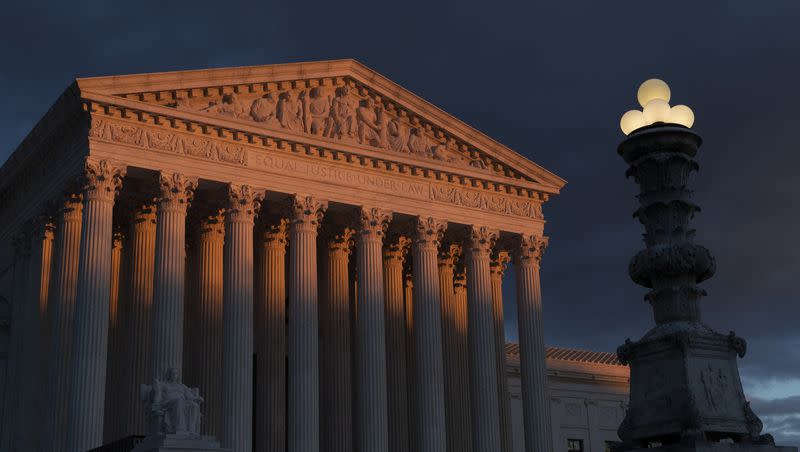Perspective: The Supreme Court has opened Pandora’s box in Texas

The current Supreme Court has staked out two portentous positions. The court has made a point of returning power to the legislative branch from the executive branch, and of returning power to the states from the federal government. Both moves have been contentious, and we are beginning to see that while each move has an upside, there’s a also downside that had previously been unforeseen. We’re seeing that play out in Texas right now.
The Supreme Court case most associated with the first move — reinforcing the power of the legislative branch vis a vis the executive — was West Virginia v. EPA, and there is an important new case pending that is liable to go in the same direction. The court has argued that the agencies of the executive branch are not free to make important policy decisions and regulations without explicit legislative approval. While on the one hand, I’d argue that this is an overdue correction by the Supreme Court, we have begun to see the unforeseen problem is that the executive branch might decide to simply ignore the rulings entirely.
President Joe Biden’s dismissal of federal student loan debt, despite the Supreme Court ruling blocking the same, is a harbinger of the real threat here. In a context where there is a divided Congress, what power is there to enforce this ruling of the judicial branch against the executive branch? None, apparently. There appears to be absolutely nothing stopping the executive branch from plowing ahead in the face of Supreme Court opposition.
This is not just a problem of what policies may or may not be executed. This is a problem of whether the checks and balances provided for by the U.S. Constitution continue to operate as they were meant to do. Has the constitutional check on executive power by the judicial branch just fallen in front of our eyes? If so, that’s a deep and dangerous crack in the American political system.
The second Supreme Court trend — that of returning power to the states — was, of course, the thrust of the crucial Dobbs decision that overturned Roe v. Wade. The Supreme Court reasoned there was no constitutionally determined right to abortion, and therefore the right to legislate on abortion was a power reserved to state governments. In the wake of that decision, we have seen state-by-state changes to abortion law, providing a stark patchwork of bans and expansions of the right to abortion among the various states.
But now Texas has raised the stakes and called the Supreme Court on this very issue of states’ rights, potentially opening up an even deeper crack in the American political system— one that unless resolved might have grave implications for the future of the country.
Texas Gov. Greg Abbott has three times called on Biden to uphold the U.S. Constitution, specifically Article 4, Section 4, which states plainly that “The United States shall protect each of them (i.e., the states) against invasion.”
Abbott asserts that with illegal crossings averaging from 7,000 to 12,000 every single day, and with a sizable additional number of “gotaways” (those not formally processed and thus not included in official statistics), that the state of Texas is being invaded, literally. And he asserts that the federal government is doing nothing to stop the invasion and nothing to ensure federal immigration law is being enforced. Twenty-five governors are backing him in this position.
Abbott has taken several steps, each increasing in intensity. First, he has bussed about 80,000 illegal immigrants to self-proclaimed sanctuary cities, including Chicago and New York City. Second, he has begun to build a Texas border wall a few miles at a time. Third, he has signed into law legislation that makes illegal entry into Texas a state crime, enabling Texas police to arrest migrants entering the country illegally. Fourth, he has mobilized the Texas National Guard and sent them to the border to maintain that state boundary, authorizing them to set up razor wire and other physical barriers to entry.
Related
So was the Supreme Court supportive of this return of power to a state government? Actually not, which is quite revealing. The Supreme Court, taking the position that the federal government is the highest authority with regards to border security, told Texas it could not prevent the U.S. government’s Border Patrol from accessing the Texas border or conducting activities such as cutting the razor wire that Texas had put in place.
Citing Article 4, Section 4, of the Constitution, Texas is now ignoring the Supreme Court’s opinion. Again, while the substantive immigration issues at hand are important, what is arguably even more important is that the balance of power between the states and the federal government has become unstable, with a state defying the federal government by defying the Supreme Court, just as we have seen that the federal executive branch is defying the legislative branch by defying the Supreme Court.
One bright spot is that this month the Texas Supreme Court refused to put a Texas independence referendum on the state ballot, so at least for the moment, Texas is not planning to secede. And yet the conflict over the southern border is, I would argue, dangerously fanning these very flames. The Biden administration is now contemplating the brinkmanship move of ordering the federalization of the Texas National Guard, risking the guard’s rebellion should it continue to obey Abbott’s orders.
Surely unintentionally, the Supreme Court has in both instances critically destabilized the government of the United States. This Supreme Court has chosen to open Pandora’s box. Maybe that was needful, but it is also perilous.
Valerie M. Hudson is a university distinguished professor at the Bush School of Government and Public Service at Texas A&M University and a Deseret News contributor. Her views are her own.

